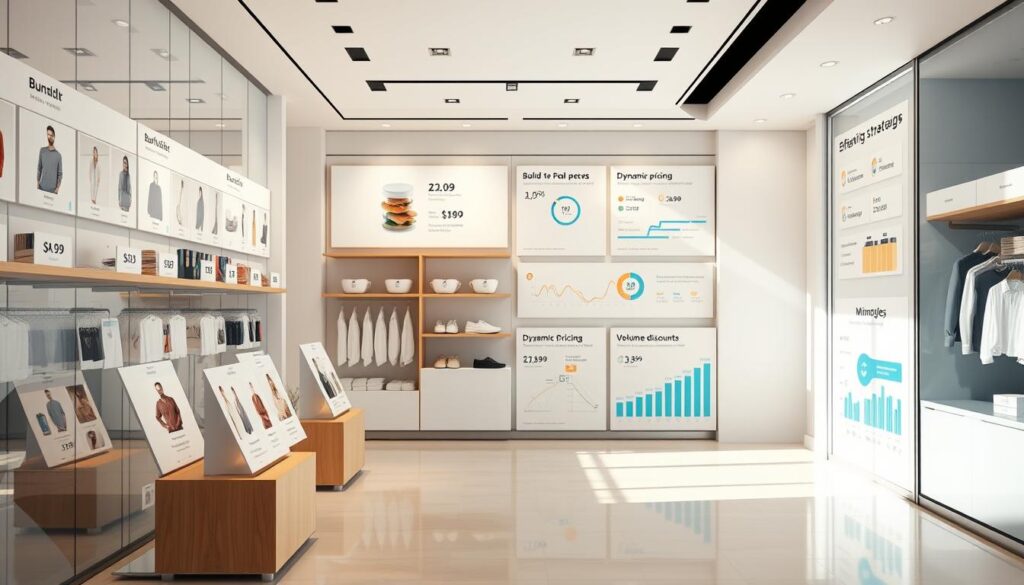Did you know the average net profit margin for eCommerce businesses is just 7%1? This stark figure highlights the challenges many online businesses face in achieving sustainable growth. With market complexity increasing, generic advice often falls short. Tailored strategies are essential to stand out and thrive.
For instance, 76% of shoppers prioritize free shipping, making it a critical factor in driving sales1. Additionally, the average customer acquisition cost is $70, emphasizing the need for smarter marketing approaches1. By focusing on proven tactics, businesses can improve margins and scale effectively.
To help you navigate these challenges, I’ve compiled 18 proven strategies used by successful clients. These insights can transform your approach and boost your bottom line. For deeper learning, explore our free webinars and e-books at digitals.anthonydoty.com.
Key Takeaways
- Average eCommerce net profit margin is 7%1
- 76% of shoppers prioritize free shipping1
- Customer acquisition costs average $701
- Tailored strategies are crucial for growth
- Free resources available at digitals.anthonydoty.com
Understanding Ecommerce Profit Margins
Understanding profit margins is the cornerstone of financial success in online business. These metrics reveal how much money your business keeps after accounting for expenses. Without this insight, it’s impossible to make informed decisions that drive growth.
Gross Profit Margin vs. Net Profit Margin
Gross profit margin measures the percentage of revenue left after deducting the cost of goods sold (COGS). The formula is simple: (Revenue – COGS)/Revenue x 100. For example, with $15,000 in revenue and $10,000 in COGS, your gross margin is 33.33%2.
Net profit margin, on the other hand, accounts for all expenses, including operating costs and taxes. It’s calculated as (Net Income/Revenue) x 100. While the average net margin is 7%, top-performing businesses achieve 20% or more3.
Why These Metrics Matter for Your Business
Profit margins are more than just numbers—they’re a reflection of your business’s efficiency. For instance, Ilia skincare optimized its $70 packaging costs, significantly improving its gross margin3. Similarly, MAC Cosmetics boosted net margins by 15% through mystery discounts3.
Understanding COGS components is equally crucial. Labor errors alone cost brands 9% annually3. By auditing supply chains, Nature Made achieved a 22% margin boost3. These examples highlight the power of margin analysis in driving profitability.
Secrets to Ecommerce Profitability: Core Strategies
Focusing on core strategies helps businesses reduce costs and improve efficiency. By implementing proven methods, you can streamline operations and maximize profitability. Let’s explore actionable steps to achieve these goals.
Reduce Operating Costs Without Sacrificing Quality
Automating routine tasks can reduce labor costs by 34% and improve efficiency3. Tools for billing and inventory management also cut unnecessary expenses. For example, restructuring staff roles saved businesses significant labor costs4.
Urban Outfitters lowered fulfillment costs by 22% with their BOPIS strategy. This approach not only reduces expenses but also enhances customer satisfaction.
Lower Customer Acquisition Costs with Smart Marketing
Email marketing delivers a 42x return on investment compared to social ads3. This makes it a cost-effective channel for reaching your audience. REI’s $20 loyalty membership increased repeat purchases by 40%, reducing acquisition costs3.
Building trust with customers also lowers costs. PrettyLitter reduced returns by 19% through transparent communication and trust-building tactics3.
Audit Your Supply Chain for Hidden Waste
Kaged reduced supply chain waste by 28% through strategic vendor partnerships3. Auditing your supply chain can uncover inefficiencies and save money. Paying invoices early can also secure vendor discounts4.
Warby Parker’s AR try-ons decreased returns by 31%, showcasing how innovation can reduce waste3. These examples highlight the importance of optimizing your supply chain.
| Strategy | Impact |
|---|---|
| Automating Tasks | Reduces labor costs by 34%3 |
| Email Marketing | 42x ROI compared to social ads3 |
| Supply Chain Audit | Reduces waste by 28%3 |
Optimize Shipping and Fulfillment
Shipping and fulfillment are critical to maintaining a competitive edge in online business. With clothing retailers allocating nearly 13% of revenue to shipping expenses, optimizing these processes can significantly impact your bottom line5. Let’s explore strategies to reduce costs and enhance efficiency.
When to Offer Free Shipping (and When to Avoid It)
Free shipping is a powerful incentive, but it’s not always the best choice. Setting a free shipping threshold can increase average order value by 27%3. For example, AllBeauty’s cart abandonment emails recovered 9% of lost revenue by reminding customers of their free shipping threshold3.
However, offering free shipping on every order can erode profits. Instead, consider alternatives like local pickup, which reduces delivery costs and improves the shopping experience5.
Prepaid Shipping and Bulk Packaging Tricks
Prepaid shipping saves 20% compared to COD, making it a cost-effective option3. Additionally, bulk packaging reduces per-unit costs by 15-18%, helping you save on inventory expenses3.
Here are some proven tactics:
- Edgard & Cooper saved $4.20 per order with bundle packaging.
- Deux increased average order value by $18.75 using “Complete the Look” prompts.
- Blume’s checkout upsell strategy lifted shipping profit margins by 12%.
- Look Fantastic’s subscription model reduced shipping costs by 31%.
“Optimizing your shipping strategy isn’t just about cutting costs—it’s about creating a seamless experience for your customers.”
By implementing these strategies, you can streamline your shipping and fulfillment processes, reduce costs, and improve customer satisfaction. Start optimizing today to see measurable results.
Boost Sales with Product and Pricing Tactics
Effective product and pricing strategies can significantly impact your sales and profits. By focusing on the right tactics, you can maximize revenue and improve your bottom line. Let’s explore how to identify your most profitable products and increase basket size through bundling and upselling.

Identify Your Most (and Least) Profitable Products
Understanding which products drive the majority of your sales is crucial. Studies show that 20% of products generate 80% of sales6. This means focusing on these high-performing items can significantly boost your profits.
For example, Halfdays increased conversions by 27% by optimizing their product content strategy6. Similarly, Oliver Bonas lifted low-margin product sales by 14% through search optimization6. These examples highlight the importance of leveraging data to identify and promote your most profitable products.
Increase Basket Size with Bundling and Upselling
Bundling and upselling are powerful tactics to increase your average order value. Quantity discounts, for instance, can boost basket size by 22%7. This strategy not only increases sales but also enhances customer satisfaction.
Beddy’s “Cozy Club” tier system boosted their average order value by $476. Ruggable’s influencer collaborations moved 300% more deadstock6. These examples demonstrate how creative bundling and upselling can drive significant results.
Interactive quizzes are another effective tool, boosting conversions by 18%8. By understanding customer preferences, you can tailor your offers to maximize sales.
“The right product and pricing strategy can transform your business, driving both sales and customer loyalty.”
By implementing these tactics, you can optimize your product offerings and pricing strategies to achieve sustainable growth. For more insights, explore our pricing strategy guide.
Enhance Customer Experience for Repeat Sales
Creating a memorable customer experience is key to driving repeat sales and building brand loyalty. With 80% of customers abandoning brands after a poor experience, focusing on this area can make or break your business9. Let’s explore actionable strategies to keep your customers coming back.
Build Trust with Transparent Policies
Transparency is essential for building trust. Clear return policies, for example, can reduce returns by 28% and improve customer satisfaction. Dorel Home saved $1.2M annually by redesigning their packaging to be more user-friendly, which also enhanced the overall experience.
NYX Cosmetics increased conversions by 14% by offering live chat support, showing how efficient customer service can make a difference9. Patagonia’s repair policy reduced returns by 22%, proving that thoughtful policies can strengthen your brand reputation.
Create a “Sticky” Loyalty Program
Loyalty programs are a powerful way to retain customers. Tiered programs, like Sephora’s Beauty Insider, drive 46% of their revenue by encouraging repeat purchases10. Shopify reports a 59% increase in returning shoppers over the past two years, highlighting the effectiveness of these programs10.
FirstMovr improved margins by 19% through data-driven product engineering, showing how personalized rewards can enhance the customer experience. For more insights on creating a customer-centric experience, explore our detailed guide.
“A great customer experience doesn’t just satisfy—it inspires loyalty and drives long-term success.”
By focusing on transparency and loyalty, you can create an experience that keeps customers engaged and coming back for more. Start implementing these strategies today to see measurable results.
Leverage Data-Driven Marketing
Data-driven marketing is reshaping how businesses connect with their audience. By leveraging accurate data, companies can create personalized campaigns that significantly boost conversion rates. This approach not only enhances customer engagement but also drives repeat sales and long-term loyalty.
Smart Product Recommendations That Convert
Personalized product recommendations can lead to a 760% increase in revenue11. Platforms like Netflix and Amazon use data analytics to suggest content, resulting in 80% of viewed content being recommended11. This strategy not only improves customer satisfaction but also drives significant sales.
For example, Petco’s “Frequent Buyer” reminders increased subscription rates by 19%. Wayfair’s augmented reality ads reduced returns by 27%. These examples highlight the power of smart recommendations in driving conversions.
Retarget Cart Abandoners Effectively
Retargeting strategies can recover lost sales and improve conversion rates. Exit-intent popups, for instance, recover 8% of abandoning carts11. Nike’s SMS retargeting lifted cart recovery by 14%, showcasing the effectiveness of timely reminders.
Shopify’s heatmap tools optimized 22% of product pages, while Glossier’s user-generated content strategy cut customer acquisition costs by $18. These tactics demonstrate how advertising and retargeting can drive results.
“Data-driven marketing isn’t just about numbers—it’s about understanding your audience and delivering value at every touchpoint.”
By implementing these strategies, you can transform your marketing efforts and achieve measurable results. For more insights, explore our detailed guide on data-driven marketing.
Innovative Tactics to Stand Out
In a crowded digital marketplace, standing out requires creativity and innovation. By adopting unique strategies, businesses can capture attention and drive growth. Let’s explore two powerful approaches that can elevate your brand and create memorable experiences for your customers.
Partner with Micro-Influencers
Micro-influencers are a game-changer for brands looking to build trust and engagement. They drive 3x more engagement compared to celebrities, making them a cost-effective choice. For example, Outdoor Voices’ TikTok challenges increased user-generated content by 300%, showcasing the power of authentic collaborations.
REI’s #OptOutside campaign improved brand perception scores by 42%, proving that micro-influencers can amplify your message effectively. By partnering with influencers who align with your values, you can create a genuine connection with your audience.
Host Interactive Shopping Experiences
Interactive shopping experiences are transforming how customers engage with brands. Shoppable posts, for instance, increase engagement rates by 20-40%, making them a valuable tool12. IKEA’s AR app allows customers to visualize furniture in their homes, driving 22% more in-store purchases12.
Live-stream shopping events boost sales by 14% by providing real-time interaction and exclusive deals. Sephora’s Virtual Artist tool increased lipstick sales by 31%, demonstrating how technology can enhance the shopping experience.
“Innovation isn’t just about technology—it’s about creating meaningful connections with your audience.”
By implementing these tactics, you can differentiate your brand and drive measurable results. Start exploring these strategies today to stay ahead in the competitive landscape.
Conclusion
Mastering the art of online business requires a blend of strategy and innovation. With an average net margin of 7%, there’s immense potential to boost profit by focusing on key areas like bundling and upselling, which can lift AOV by 34%13. Advanced tactics, such as AR implementations, have shown a 28% conversion lift, making them a game-changer for growth7.
Auditing your supply chain can reduce waste by 19%, ensuring every dollar counts13. By leveraging these strategies, you can create a significant impact on your bottom line. Start optimizing today to unlock your business’s full potential.
For deeper insights, explore our exclusive profit calculators and Q4 planning webinars at digitals.anthonydoty.com. Take the next step toward sustainable growth and long-term success.
FAQ
What’s the difference between gross and net profit margins?
Gross profit margin focuses on revenue minus the cost of goods sold, while net profit margin includes all expenses like marketing, shipping, and overhead. Both are crucial for understanding your business’s financial health.
How can I reduce operating costs without lowering quality?
Focus on streamlining processes, negotiating with suppliers, and using technology to automate repetitive tasks. This helps cut costs while maintaining the quality your customers expect.
Should I always offer free shipping?
Not necessarily. Free shipping works best when it’s tied to a minimum order value or during promotions. Analyze your profit margins to ensure it doesn’t eat into your revenue.
How do I identify my most profitable products?
Use data analytics to track sales, margins, and customer demand. Focus on products with high margins and strong sales performance to maximize your revenue.
What’s the best way to increase basket size?
Use bundling, upselling, and cross-selling strategies. Offer complementary products or discounts for larger orders to encourage customers to add more items to their cart.
How can I build trust with my customers?
Be transparent about your policies, including returns and shipping. Provide excellent customer service and ensure your website is secure and easy to navigate.
What are smart product recommendations?
These are personalized suggestions based on customer behavior, like past purchases or browsing history. They increase conversion rates by showing relevant items shoppers are likely to buy.
How do I retarget cart abandoners effectively?
Use email or ads to remind customers of their abandoned carts. Include incentives like discounts or free shipping to encourage them to complete their purchase.
Why partner with micro-influencers?
Micro-influencers often have highly engaged audiences. Their recommendations feel authentic and can drive targeted traffic to your store without the high costs of bigger influencers.
What are interactive shopping experiences?
These include live streams, virtual try-ons, or quizzes that engage customers. They create a memorable experience, boosting brand loyalty and sales.








